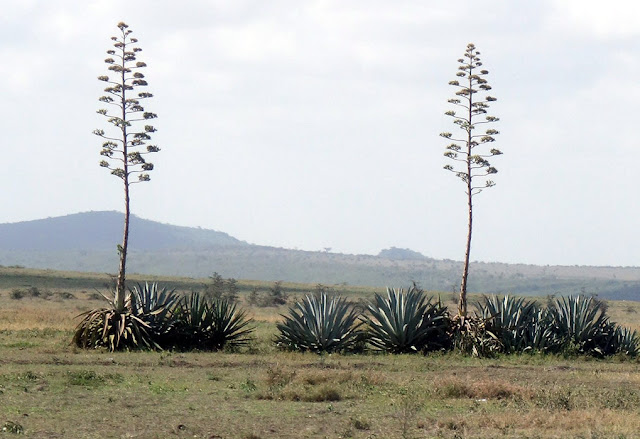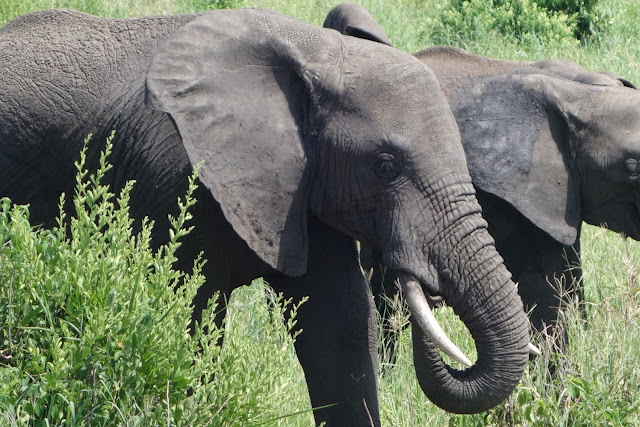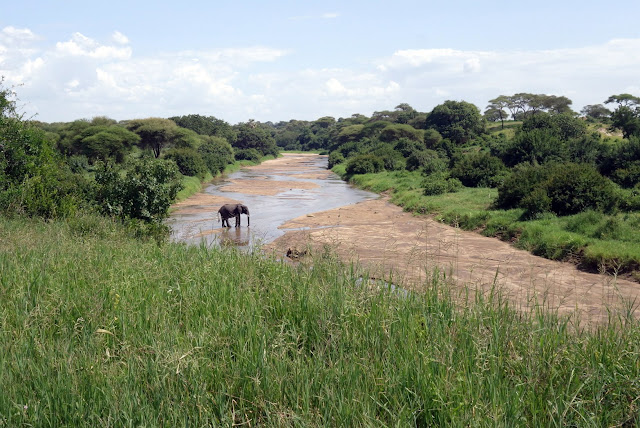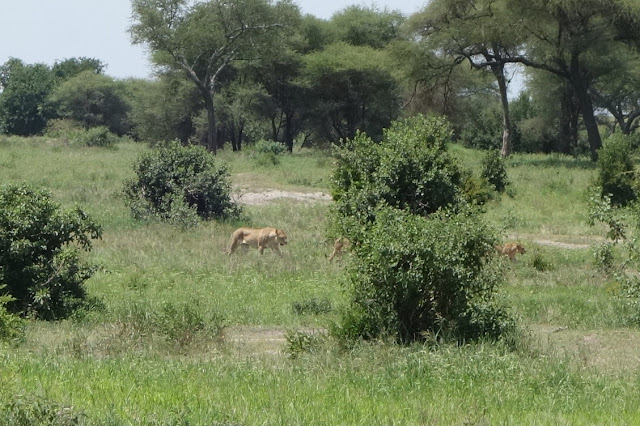If you want to skip the introduction and the wordiness, just scroll down to where pictures of animals begin and enjoy! (For more information on a topic, click on words in purple.)
 |
| Nava and Havazelet in front of the Kilimanjaro International Airport |
Our guide, Fitiael picked us up at the airport and drove us to our hotel in Arusha. On the way he told us a bit about the crops grown in the area, including corn, beans and sunflowers for oil. Nearby in a slightly less dry area, we saw coffee and bananas growing, and saw several people herding animals along the highway.
. We stopped at a local market and at first saw tables full of used clothing,
Many fruits and vegetables were artfully displayed, mostly on cloths on the ground.
 |
| Small red onions |
 |
| All kinds of greens, including squash greens, for sale |
 |
| Yams (white) |
Dried corn and beans were plentiful as were small dried fish used to season food and for
protein.
We also saw a sorter and grinder for making corn flour.
Fitiael told us that Tanzania had 19 kinds of bananas, some for eating raw and others for cooking in stews or frying, as was done by one woman in the market.
In a Zanzibar market, we saw the largest, called elephant tusk bananas!
Nava said that the bananas tasted better than most in the U.S.
 |
| A mostly banana stand right outside the market |
When we got to our hotel, the Arusha Planet Lodge, Helen (a friend of mine from Temple Emunah in Lexington, MA) was waiting to greet us. She officially met Nava and Havazelet and our foursome was complete. We talked with Fitiael about the next day and took our first picture together.
 |
| Me (Dina), Fitiael, Havazelet, Nava, and Helen |
 |
| Each cute hut had two rooms, similar to some Masai style of huts. |
Achmed (originally Paul, from England), the owner of Base Camp Tanzania met us at the hotel to give us some background information on what we would be doing. We tasted Kilimanjaro beer.
He told us that there were about 120 tribes in Tanzania, each with its own language. Kiswahili (also called Swahili) is the common language of the people and the official language of Tanzania as well as Kenya, Uganda,and the DRC. It is a Bantu language with a significant amount of Arabic as well as some Hindi, German, and Portuguese (from past people living here). It is a first or second language spoken by over 100,000,000 (yes, one hundred million!) people.
Tanzania is at most 40% Muslim and at least 45% Christian plus indigenous religious. Zanzibar (and coastal cities) is heavily Muslim but "light" Muslim. Tourism accounts for about 17% of the economy. Agriculture is a large part of the economy as is Tanzanite and mining--especially gold. About 58 million people live in Tanzania, and Arusha is the third largest city.
We walked around the hotel gardens a bit and then had a lovely dinner in the hotel restaurant.
We were astounded at how tall the banana plants were, over two stories high in some places! Notice the purple flower hanging under the banana stalk.
 |
| A stunning flower in the garden |
The next morning, our first stop was at the Base Camp Tanzania office to make final payments.
Achmed had a very good map on his office wall. After leaving the office, we headed south on a paved (tarmac) road to the Tanganire National Park, in the central lower part of the map.
On the way there, we saw a lot of extremely tall sisal plants, similar to century plants that I had seen in Arizona. In 1893, Sisal plants were smuggled into Tanganyika from Mexico in the belly of a stuffed crocodile, and until 1961, the country was the number one producer of sisal.
We went out in Tanganire park that afternoon for our first safari drive. The park was established as a national park in 1970 and is home of more than 550 bird species.
Tanganire means place of ('tar') the wart hog ('Ngere') and Havazelet sited the first animals in the park, wart hogs.
Baobab trees are also plentiful in this park, most had filled out from the October-November rains and were bound to get fuller with the rains beginning in mid-February.
The trunk of the tree is uneven.
We also saw the baobab fruit which are eaten when they are yellow.
These trees can live for over 1000 years, but they are not replenishing themselves as the new shoots are often eaten or trampled on by elephants. And older trees can be damaged by animals, especially elephants, taking off the bark and getting water from the spongy center during the dry season.
We were delighted to see that most bathroom stops were well taken care of and comfortable to use. At one such stop before entering the park, we saw a group of men of the Makonde tribe carving animals form ebony, mahogany, and rose wood. They started learning their tribal carving skills at age 10.

We saw an Abdim's stork, which is a rare sight in this park.It has a blue face and red markings on its legs. It's in Europe in the summers but here during European winters.
We saw many animals including two jackals racing by, elephants (the park is known for a large number of them), lionesses and a number of birds including red and yellow barbets, ashy starlings, superb starlings (soon to be my favorite small bird). We also saw Black headed herons, African spoon bills, Sacred ibises, and Egyptian geese.
sunbirds, etc, and vervet/black-faced monkeys at the rest area.
 |
| A Eurasian Collared Dove |
sunbirds, etc, and vervet/black-faced monkeys at the rest area.
 |
Superb starling--isn't it stunning! Havazelet called it a super-superb starling |
Right next to a small lake we saw a collection of birds and then
Below are our first sighting of elephants, cooling off and playing. These two were probably about 16. Males stay with their mothers until about age 13 or 14 and then form bachelor groups or join other already formed ones.
Termite mounds were plentiful in the Tarangire area and quite big. The mounds also extend to underground tunnels too. A queen can live up to 60 years but most live about 15. Termites eat grass here.
 |
| Nava, Helen and Havazelet |
 |
| Superb starling and red-billed Hornbill |
After lunch, we got our first glance of the many animals in the antelope family--i.e. all members of the bovidae family NOT including cattle,sheep, and goats. There are 91 species of antelope, 72 of which are native to Africa. The most common species of both antelopes and gazelles in Tanzania’s ‘northern circuit’ include Grant's gazelles, Thomson's gazelles, impalas, wildebeests (also known as gnu), hartebeests and topi. We saw all of them, plus dik diks too, the tiniest ones.
and then we had our first sightings of groups of baboons, including the mother in the middle of the picture below with a baby hanging on underneath her.
Another, a bit older riding on mom's back--it has great balance--and another waiting while Mom rests a bit.
and several warthogs walked nearby.
One young baboon sat on a termite mound. Baboons eat termites.
Along the way, we saw part of a skull, maybe a warthog? We saw almost no bones as one of the small scavengers (hyena, I believe) can crush and eat them.
A few minutes later, under a baobab tree, we spotted our first giraffe. Adult giraffes have no natural predators as they can kick with their hind legs and seriously hurt a lion.
A bit ahead, we spotted a bird watching a small herd of elephants.
Some resting in the shade of an acacia tree. Note the very young elephant in the middle, about 3 months old, protected by the adult females. Pregnancies for elephants last 22 months. When the baby is two to four years old, she can get pregnant again. The elephant's life span is about 70 years. There is no dominant male, but rather a female leader.
A youngster off to the side eating.
Elephants are herbivores and need 16 to 17 hours to eat enough and only digest 40-50% of what they eat . They rest standing under trees 2-3 hours in the heat of the day. They are up and down eaters, eating leaves (up) and a lot of grass down.
Note their extremely long eyelashes.
Elephants have two tusks and four huge teeth, two on the lower jaw and two on the upper jaw. Every ten years they four teeth are replaced with new ones, getting six sets in a lifetime, but after age 60, they get no more. They use their tusks to peel bark off of trees, to dig, and as weapons. Their other weapon is their feet, which they can use to stomp other animals.
Below a solitary elephant drinks from the water of the Tanganire River, the largest river in the park. It never dries out, but it is spotty now as there was a short rain season in October and November after a long dry season. The longer rainy season from late February til May was due to start soon, and the river will then fill up.
A group of warthogs followed including a younger one.
We saw a few male impalas, closer to our vehicle.
More elephants cooling off in the afternoon.
Other elephants crossing the road in front of our vehicle. They have the right of way.
That night and the next we stayed in luxury tents next to the Tarangire Safari lodge.
We were just down the path a bit from the lodge and outdoor pool.
A huge boabab tree stood in front of some of the "tents."
Below is a monkey outside of our tent on the path, looking for something tasty to eat.
One of our tents.
Helen and Nava look out at the savanna below the patio of the hotel. That afternoon before we returned from our outing, hundreds of elephants crossed through that area. We were told it was quite a sight!
 |
| Human animals sighted in the pool |
 |
| Another red-billed Hornbill |
 |
| Black Faced Sand Grouse by the road |
 |
| Female water bucks |
 |
| Male water buck with antlers off to the side resting |
 |
| Leopard tortoise |
Here are some of the many birds we saw that morning--up in trees or down on the ground.
 |
| Sacred ibises by a small lake |
Above, possibly a Tawny Eagle or an African white-backed vulture. We saw both at this time and also a black shoulder kite, elementary guinea fowls, and yellow necked spar fowls.
We saw a few baboons coming from the right and crossing the road, and then more and more came!
 |
| Horn bills |
We saw one baboon, and then many many more followed.
In all there must have been over a hundred.
A bit further down the road we saw a few more, close to a group of elephants.
 |
| No hands and sitting on mom"s tush! |
Below are baby elephants who have not started to grow tusks yet. They usually begin to grow them at 2-3 years of age.
Up-eaters, eating leaves...and cute baby elephant tushies
Below is a broken branch from an elephant rubbing against it.
Mongooses often reside on termite mounds, usually abandoned ones. Below is a pack of slender mongooses. They eat termites and other insects.
It was amazing to see a large group of ostriches. The first picture of part of the group was taken with a zoom lens.
Fitiael drove around on the road and got a closer sighting and we got the next two photos..
Ostriches can run 65 kilometers per hour (over 40 mph)
Female ostriches share a nest after the dominant male digs one in the ground. A maximum of 9 eggs can be in the nest. The first to lay an egg sits on the eggs during the day and the male sits on them at night. When the ostriches are 4-5 months old, they are fully grown. The males have pink on their legs and neck at mating time. Cheetahs hunt them.
A black-faced monkey at the rest stop.
She preferred to take refuge under a bench.
A group of impalas crossing the road

We passed by the Tanganire River several times, the main source of fresh (sweet) water in this park.
We also saw lions in the distance and then very close to the road.
We were a bit too disturbing for them, so they walked away.
Some of the dead umbrella acacias were quite picturesque.
This young lion was RIGHT in front of us on the road but soon decided to move a bit.
We saw a herd of water buffalo not far away. They can be particularly vicious, so our driver kept a safe distance.
After a nice late afternoon outing, we headed back to our luxury tent for dinner.
Dinner in the Tanganire Lodge restaurant
Butterflies of Northern Tanzania
Delightful 21-year-old woman, Susan, who served as our waitress.
That morning we left Tanganire Park and headed to to the Ndutu area of Ngorongoro.
More will follow in the second Blog of our safari in Tanzania.















































































